October 1, 2004
Air Date: October 1, 2004
FULL SHOW
SEGMENTS
Preserving the Wilderness
View the page for this story
PART ONE: Declaring an area as federal wilderness can be a lengthy and partisan process, but when the original Wilderness Act became law forty years ago, it was a much different and bipartisan climate that made its passage possible. Host Steve Curwood talks with Stewart Udall, former secretary for the Interior Department under the Kennedy and Johnson administrations, about what he considers the Golden Age of the environment.
PART TWO: One million acres of land in three states are now being considered for wilderness status, but these areas must meet with Congressional approval first. As Living on Earth’s Jeff Young reports, there’s much opposition to these proposals on Capitol Hill.
PART THREE: Idaho’s Boulder-White Cloud Mountains make up the largest unprotected roadless area in the lower 48 states. For years, conservationists have been pushing to protect this area as wilderness, with little success. Reporter Guy Hand visited the mountains and found there’s an increasingly powerful group that wilderness advocates will have to contend with.
PART FOUR: The Old English derivation for wilderness means quite literally, wild beast. As this week marks the 40th anniversary of the Wilderness Act, Steve Curwood remembers a close encounter at summer camp that personally reinforced the very definition of wilderness. (28:15)
Emerging Science Note/Canine, M.D.
/ Jennifer ChuView the page for this story
Living on Earth’s Jennifer Chu reports on a study that finds dogs may have a nose for sniffing out cancer. (01:20)
Listener Letters
View the page for this story
We dip into the Living on Earth mailbag to hear what listeners have to say. (02:30)
Some Like It Hot
View the page for this story
Whether you like your buffalo wings mild or spicy may depend on your genes. So says Gary Nabhan, whose new book is called “Why Some Like it Hot: Food, Genes and Cultural Diversity.” Host Steve Curwood talks with Nabhan about how the environment shapes our cultural diet and our genes, and how these ideas came into sharp focus after a well-intentioned dinner went sour. (12:45)
This week's EarthEar selection
listen /
download
Show Credits and Funders
Show Transcript
HOST: Steve CurwoodGUESTS: Stewart Udall, Gary NabhanREPORTERS: Jeff Young, Guy HandNOTE: Jennifer Chu
[THEME MUSIC]
CURWOOD: From NPR, this is Living on Earth.
[THEME MUSIC UP AND UNDER]
CURWOOD: I’m Steve Curwood. As the first law that defines federal wilderness turns forty, the debate continues over what humans should be allowed to do in these officially untamed places. Some folks want their time with nature to be as pristine as possible and so they want to keep off-road vehicles off these wild lands.
LAGRANDE: They have this huge cocoon of noise and kicked up dirt ... They're being wild in their own recreation, but they're destroying the wilderness for everyone else.
CURWOOD: But others say too much land is being classified wilderness, and at their expense.
WILLS: I think it's a bad idea mainly because there's already almost two and a half million acres of wilderness area in the surrounding areas here already. And adding more wilderness just cuts out more areas for an ever expanding off-road vehicle population.
CURWOOD: It’s the state of wilderness - past, present and future, this week on Living on Earth. So stick around.
[NPR NEWSCAST]
ANNOUNCER: Support for Living on Earth comes from the National Science Foundation and Stonyfield Farm.
Preserving the Wilderness
CURWOOD: From the Jennifer and Ted Stanley Studios in Somerville, Massachusetts, this is Living on Earth. I’m Steve Curwood.
These days, the process of officially designating wild land as wilderness can be as rugged as the physical terrain itself. Getting a wilderness bill through Congress can spark a partisan battle between those who strive to preserve it in a natural state, and those who don’t want to see it locked up.
It’s a far different political climate compared to 40 years ago. That’s when President Lyndon Johnson signed the Wilderness Act - an unprecedented national policy that was meant to guarantee, quote, “an area where the earth and its community of life are untrammeled by man, where man himself is a visitor who does not remain.”
Today, nearly five percent of all the land in this nation is protected under the Wilderness Act, and as we mark its anniversary we’re taking a look at the past, present, and prospects for its future.
First, for an historical perspective we turn to Stewart Udall, former secretary for the Department of Interior under the Kennedy and Johnson administrations. Mr. Secretary, you were a witness to the drafting and inception of the Wilderness Act. How would you describe the political atmosphere at the time?
UDALL: Well the political atmosphere, it was just the right time for a new big idea like this, you know. No other country in the world had a wilderness policy. And it just struck a chord. It was very popular in the 1960s. Now, we had to fight, and it took four years to get it done, but it turned out there was overwhelming support in this country.
Senator Anderson, a powerful senator from New Mexico, who had known Aldo Leopold, a great conservationist – he decided to push it. And he said to the president, put it in your message to Congress, a call for a wilderness bill along the lines of my bill. And that started it. He had hearings and a vote in the summer of 1961 and it passed overwhelmingly.
And all of us – I was startled, even, at the margin by which it passed the Senate, which I think was 78 to 12. And what were the 12? Six Republicans, six Democrats. That shows you it was bipartisan, and it was across the country. We had tremendous support for it. And this was really an expression of the desires of citizens – tens of thousands of people all over the country became wilderness advocates and wrote their Congressmen and Senators and came to Washington.
CURWOOD: It seems that the Wilderness Act, and a lot of other major environmental laws that were passed at the time, weren’t seen as partisan issues. There wasn’t a particular Republican or Democratic tag to it. It sure seems very different today.
UDALL: I had so many friends, we never had arguments, we had the same values and the same beliefs. And it was a wonderful time, kind of a Golden Age of the environmental movement.
CURWOOD: Secretary Udall, when did the shift take place in American politics when conservation issues became more partisan?
UDALL: I’m afraid I have to say it took place under the Reagan administration. It was considered by the public officials of that time that we had enough national parks, we had enough wilderness, that we were interfering with the economy of the country. And the old philosophy was lost. The philosophy we developed in Republican presidents – Nixon was a good president, Ford was a good president -- this carried across party lines and we never had big partisan arguments. It’s hard to believe that today, isn’t it?
CURWOOD: Secretary Udall, what are the odds that the Wilderness Act could be written today and would pass in today’s political environment?
UDALL: My answer is a sad answer. I believe if you proposed the wilderness bill today, it would not go through Congress. The divisions are so sharp and the ideologies are so different that I doubt it would get to first base.
CURWOOD: Now, the author of the Wilderness Act was a man by the name of Howard Zahniser who I believe had worked on it actually for several years before even the Kennedy administration came into office. Could you describe the man behind the Wilderness Act, and what he was like in person?
UDALL: Well, Howard Zahniser was a small town boy over in the Allegheny Valley in Pennsylvania. I’d describe him as a sweet, patient person. We began to call him a saint because he had to face so many obstacles. And the Congressman that was holding up the bill, a powerful Congressman from Colorado, would come up with a new argument every week, it seemed at times, against the bill. He would rewrite sections of the bill if he had to make changes, and he was a very good strategist. If you had met him you wouldn’t believe that because he was very quiet and very patient. He died three months before the bill passed. Never saw it become law.
CURWOOD: What is it about the language of the Wilderness Act that you find remarkable or stirring looking back at it now?
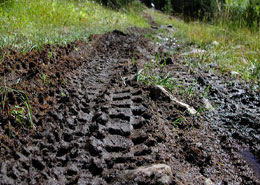
Dirt bike tracks on a muddy trail. (Photo: Guy Hand)
CURWOOD: Stewart Udall is former Secretary of the Interior under Presidents Kennedy and Johnson. Mr. Udall, thanks for taking this time with me today.
UDALL: Glad to be with you.
CURWOOD: The Wilderness Act gives Congress the power to declare wilderness areas and protect land from logging, mining, roads and motorized transport. In this 40th anniversary year of the Wilderness Act, wilderness advocates hope Congress will grant that protection to about a million more acres in three states. But there is plenty of opposition on Capitol Hill as the clock runs out for this session of Congress. Living on Earth’s Jeff Young has our report.
YOUNG: Congress is considering wilderness proposals from Nevada, New Mexico and Washington, all with strong support from area citizens and lawmakers. Wilderness advocate Doug Scott says those are the crucial ingredients for protecting wild lands.
SCOTT: This could be a great wilderness Congress and in the 40th anniversary year of the Wilderness Act that would be a fitting thing for the Congress to do. These are solid proposals, bipartisan, supported locally. That’s the kind of wilderness protection that can pass.
YOUNG: Scott lobbies for the Campaign for America’s Wilderness and recently wrote a history of the Wilderness Act. He hears echoes of that history in the current wilderness debates. He was heartened to hear a bit of the old bipartisan spirit on wilderness when the Senate considered Nevada’s wilderness proposal. It’s the largest before Congress this session, with nearly three quarters of a million acres in the state’s southeast. Both Nevada senators, Republican John Ensign and Democrat Harry Reid, support it. Reid says that support came through compromise on tough issues, like water rights and underlying ideological differences.
REID: It’s a very good bill because Senator Ensign and I are both unhappy with it. I think that’s a good sign that the bill is good.
YOUNG: A bill from Washington state would protect about 100,000 acres in the mountains northeast of Seattle as the Wild Sky wilderness. The Republican-controlled Senate approved it but it’s a different story in the House.
POMBO (IN COMMITTEE): Are there any members who wish to make a very, very short statement about the bills which are part of this motion? Seeing none…(fades under)
YOUNG: California Republican Richard Pombo, an outspoken critic of many environmental laws, chairs the House Resources Committee. Pombo did not like the Senate’s idea for Washington’s Wild Sky and worked to reduce its boundaries by 13,000 acres. Pombo says that land does not qualify as wilderness because it bears marks of old logging, such as roads and culverts.
POMBO: I believe wilderness is a very special status of protection that we have as a tool to protect land. It is not something that anyone ever imagined that we would be including roads and bridges and dams and developed areas and try to call them wilderness.
YOUNG: Wilderness advocate Scott says he’s heard that argument before. He says the answer lies in the carefully chosen words of the Wilderness Act’s author.
SCOTT: In its ideal definition the Congress in the Wilderness Act says that a wilderness area is an area where the earth and its community of life are untrammeled by man. I didn’t say untrampled. A trammel is a net. So the idea is that in these places we draw a line around ‘em and say in there as best as we can we’re gonna restrain ourselves and we’re gonna let the forces of nature shape what happens.
YOUNG: Scott says the Act focuses on what the land could become. And he says Congress has approved many wilderness areas on scarred land.
SCOTT: There’s a record of precedence and interpretations going back to the debates on the Wilderness Act itself. We are utterly sure we’re on solid ground here, and that those who are saying that, “no, no, this law has to be applied in more narrow minded way” are simply wrong.
YOUNG: Wrong or right, Congressman Pombo is still chairman of the Resources Committee. He pulled the Wild Sky proposal, leaving it unlikely to pass this session.
The committee approved Nevada’s wilderness bill after Pombo removed three areas from its protection. A third bill also passed to protect some 11,000 acres of New Mexico as the Ojito wilderness. Those bills now go to the House floor for a vote.
But wilderness advocates say there’s one more obstacle waiting at the other end of Pennsylvania Avenue. President Bush has signed only four wilderness bills in his term, protecting about half a million acres. That’s the least of any president in 40 years—far less, for example, than the nearly four million acres protected by his father.
Wilderness Society spokesperson Pete Rafle says the Bush administration also targeted for development places citizens wanted for wilderness by leasing those lands to oil and gas companies.
RAFLE: I think the message has come through loud and clear from the top down: this administration really isn’t interested in protecting more places forever wild.
YOUNG: This is also, of course, an election year, when conventional wisdom says politics make it even tougher to get things done in the Capitol. But wilderness advocate Doug Scott sees the election working in his favor. The three pending wilderness areas are all in battleground states in the presidential race, giving the president an opportunity to improve his environmental image.
SCOTT: If the timing worked out so that before the election President Bush were having a signing ceremony to add that area to the wilderness system, the wilderness movement will be there cheering.
YOUNG: With just a few weeks left for action in Congress, it’s unclear which wilderness bills, if any, might reach the president’s desk. For Living on Earth, I’m Jeff Young in Washington.
[MUSIC: David Grier “King Wilkie’s Run” PANORAMA (Rounder – 1997)]
CURWOOD: Coming up: the politics of preserving a special place in Idaho. Keep listening to Living on Earth.
[MUSIC: David Grier “The Skeleton” PANORAMA (Rounder – 1997)]
CURWOOD: It’s Living on Earth, I’m Steve Curwood. As we've heard so far in this program, getting Congress to designate land as official wilderness can be difficult. It's hard enough to create a national park or monument where paths and boats and buildings are allowed. Wilderness is far more restricted, or protected.
In Idaho, conservationists have been trying and failing, for 20 years, to preserve the largest unprotected roadless area in the lower 48 states: the Boulder-White Cloud Mountains. Now a Republican Congressman is trying again.
Producer Guy Hand visited the Boulder-White Cloud and found that 40 years after the passage of the Wilderness Act, power is slowly shifting away from traditional opponents – like ranchers, miners and loggers —in favor of another, increasingly powerful group.
[SOUND OF STREAM FLOWING]
|
HAND: It's not surprising that everyone up here loves the remote Boulder-White Clouds of Central Idaho. Between these spectacular jagged peaks, the headwaters of several major rivers flow, from high alpine meadows, through pine and aspen, down to dry sagebrush. It's varied enough for mountain goats, big horn sheep, wolverines, and wolves. So, people are united by why they come here, but divided by how they get here. [SOUND OF DIRT BIKES] WILLS: We're all members of the Magic Valley Trail Machine Association from Twin Falls.
|

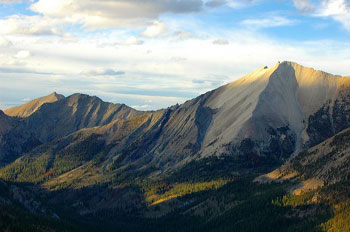 The Boulder-White Cloud Mountains in Central Idaho is an area that some believe should have wilderness protection. (Photo: Guy Hand)
The Boulder-White Cloud Mountains in Central Idaho is an area that some believe should have wilderness protection. (Photo: Guy Hand) 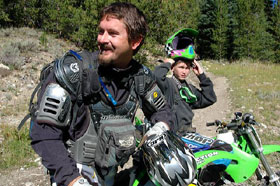
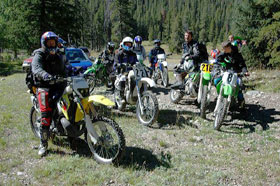 Top: Jamey Wills of the Magic Valley Trail Association is against more wilderness. Bottom: Members of the Magic Valley Trail Association. (Photos: Guy Hand)
Top: Jamey Wills of the Magic Valley Trail Association is against more wilderness. Bottom: Members of the Magic Valley Trail Association. (Photos: Guy Hand) 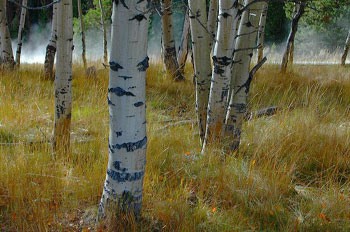 A White Cloud aspen grove, one of the proposed wilderness’s varied habitats. (Photo: Guy Hand)
A White Cloud aspen grove, one of the proposed wilderness’s varied habitats. (Photo: Guy Hand) 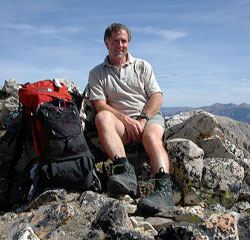 Ed Cannady, the Forest Service’s back country manager, on top of a peak in the Boulder-White Cloud Mountain. (Photo: Guy Hand)
Ed Cannady, the Forest Service’s back country manager, on top of a peak in the Boulder-White Cloud Mountain. (Photo: Guy Hand) 



